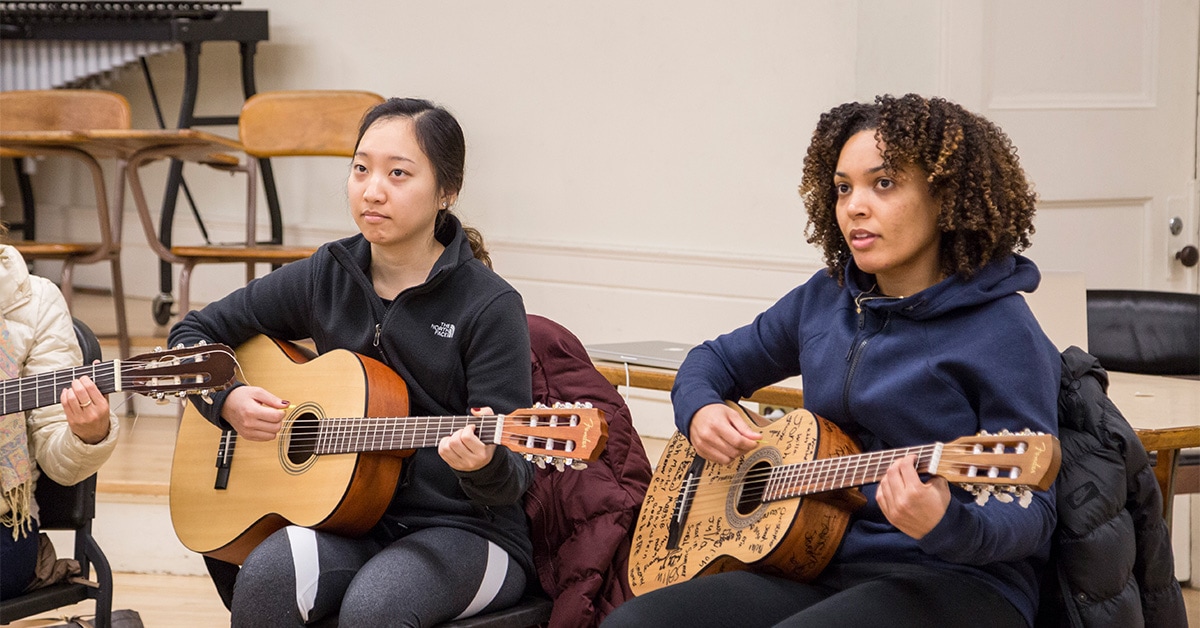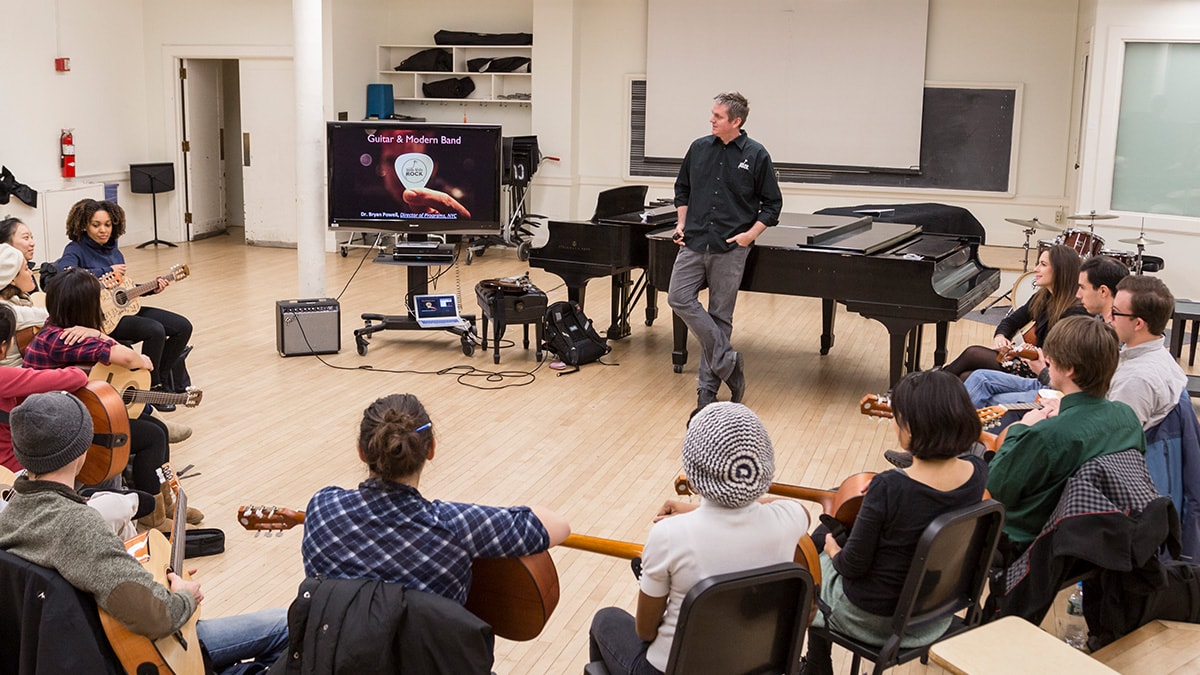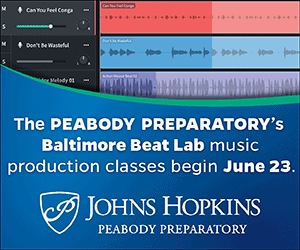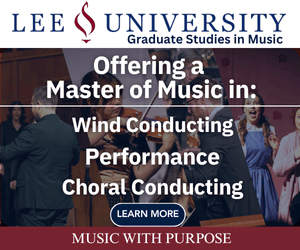NAfME BLOG
Three Tips for Teaching Music Online, from Teachers College, Columbia University

/ News Posts / Three Tips for Teaching Music Online, from Teachers College, Columbia University
Three Tips for Teaching Music Online, from Teachers College, Columbia University
Sponsored by Teachers College, Columbia University Master of Arts in Music and Music Education
Teaching online poses unique opportunities and challenges for music teachers. Along with instruction, we must devise new and effective ways to rehearse and perform in a virtual environment. Faculty and alumni from the Hybrid Summer Master of Arts in Music and Music Education (M.A. M&ME) at Teachers College, Columbia University share their approach to teaching music online, including creating an entirely virtual ensemble; suggested technology platforms; and advice for overcoming obstacles.
1. Adapt Your Pedagogy
Professor Jeanne Goffi-Fynn oversees performance at Teachers College (TC) including recitals, ensembles, and college-wide events. One of Goffi-Fynn’s favorite interfaces is Acclaim, which allows the music instructors in her classes to upload teaching videos and receive feedback from peers in real time.

“If students find something they like, they can comment, ‘Oh, great moment,’ or ‘Did you notice what your student was doing right there?’ Because you can respond throughout the video, students get a much more interactive experience than watching the entire thing and giving only reflective statements afterward,” she said.
Goffi-Fynn explains when TC first tried to create its virtual ensemble, they faced some challenges. Initially, the plan was to have students submit their individual video performances, so one person could compile the clips.
However, this quickly overloaded the compiler’s computer. According to Goffi-Fynn, this experience helped to drive home the importance of adaptability. Teachers may not be able to replicate the exact same lessons that they would teach in person, but they can make adjustments to achieve the same results.
“When looking at material versus pedagogy and comparing online to in-person classes, the pedagogy is truly what’s changing,” Goffi-Fynn said. “We can’t have 25 people singing at the same time. But the content is still the same. We can still do warm-ups, we still want to understand how the voice works, and we still want to have good teaching strategies that promote engagement and a community mindset.”
“Stay optimistic, be as creative as you are in your in-person classes, and get to know your students’ strengths and weaknesses.”
Goffi-Fynn advises online music teachers to “stay optimistic, be as creative as you are in your in-person classes, and get to know your students’ strengths and weaknesses.” When working with adults who may be more nervous about technology, she begins with group Zoom calls, then transitions into breakout rooms before asking them to post their videos.
Making students aware of resources, offering support for questions, and ensuring they feel heard and respected are also crucial.
“Acknowledging real issues is vital in any classroom. Conversations are just as important as the content that is learned in the classroom,” Goffi-Fynn said.
2. Try Your Own Lessons First
Drew X Coles is a multi-instrumentalist, composer, arranger, producer, serial entrepreneur, and educator who teaches applied lessons, ensembles, and music entrepreneurship at Teachers College. He finds that the best way to iron out the flaws when your lessons need to change is to put yourself in your students’ shoes.

“Try everything yourself,” Coles said. “Anything that you make your students do, you should do first. Get a group of friends together and walk through the process. By bringing the project from beginning to end, you’ll learn a lot about how to run it in the classroom. If you don’t work through things on your own, you’ll have no idea what hurdles your students face or how to address them.”
“Anything that you make your students do, you should do first.”
Among Coles’ tech recommendations are Logic Pro X, GarageBand, Soundation, Sibelius, and Google Drive.
“Google Drive is the unsung hero. It’s imperative that I meet the students where they are, and Google Drive is an easy and free way for them to upload recordings and other material,” he said.
One of the advantages of teaching music online is allowing students to be comfortable in their own space, which doesn’t always happen in the physical classroom, Coles noted. The ability to view a recording of a performance on-demand is yet another.
Coles, and his fellow faculty members in the M.A. M&ME do all they can to make the learning experience great.
“I came to Teachers College to figure out how to change people’s lives,” he said.
3. Use Music to Connect
Although you’ll no doubt face challenges as you create virtual learning experiences, the end result can be transformative for both you and your students. For Natalie Fabian, a vocalist, pianist, composer/arranger, teaching artist, and recent graduate from the M.A. M&ME program, practicing together and collaborating on performance offered a way to connect with other musicians.
“The most rewarding part of this was watching the finished product and finally seeing the work come together.”
“The most rewarding part of this was watching the finished product and finally seeing the work come together,” Fabian said. “And then, at the end of the semester, we were presented with beautiful videos of everyone singing simultaneously, a symbol of the hard work coming to fruition.”
Fabian is currently the Director of the Every Voice Youth Choir, part of a non-profit organization hosted at TC called Every Voice Choirs. She is also the Graduate Voice Instructor at TC.
For editing video, Fabian recommends Final Cut Pro, Davinci Resolve, and iMovie, though iMovie can be challenging when compiling videos for ensembles greater than 15. For audio mixing, Fabian has found Logic Pro X, a condenser microphone, and an audio interface to be helpful. To make recordings, her students utilize Zoom, iMovie, and PhotoBooth.
Fabian describes organization as a “vital piece” of teaching online, since there are many students and possible submission methods to juggle. She also says that clear communication, including setting deadlines for assignments, is essential.
About Teachers College M.A. in Music and Music Education
The Hybrid Summer Master of Arts in Music and Music Education (M.A. M&ME) at Teachers College, Columbia University is designed for professionals who seek to transform themselves, their students, and their communities. With an academically rigorous curriculum and on-campus experiences, our program equips graduates with a diverse and rich skillset they can use to tap into their passions and become a driving force in the transformation of music education.
Interested in reprinting this article? Please review the reprint guidelines.
The National Association for Music Education (NAfME) provides a number of forums for the sharing of information and opinion, including blogs and postings on our website, articles and columns in our magazines and journals, and postings to our Amplify member portal. Unless specifically noted, the views expressed in these media do not necessarily represent the policy or views of the Association, its officers, or its employees.
May 10, 2022. © National Association for Music Education (NAfME.org)
Published Date
May 10, 2022
Category
- Preparation
- Technology
Copyright
May 10, 2022. © National Association for Music Education (NAfME.org)



